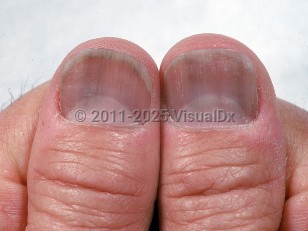Longitudinal melanonychia - Nail and Distal Digit
Alerts and Notices
Important News & Links
Synopsis

Melanocytes normally reside in the nail matrix and nail bed, but they are typically inactive in individuals of Northern European descent. In the nail matrix, if melanin production by melanocytes is greater than degradation by keratinocytes, the result is a longitudinal band. This phenomenon can be caused by melanocyte activation, melanocytic hyperplasia, lentigo simplex, melanocytic nevus, atypical melanocytic proliferations, and acral lentiginous melanoma.
Pediatric nail melanoma is extremely rare, particularly in individuals with Fitzpatrick phototypes I and II, but carries significant morbidity and mortality. The fingernails are more commonly involved than toenails. Evaluation of longitudinal melanonychia is more difficult in children than adults due to lack of clinical and histopathological guidelines. According to recent cohort studies from Asia, the majority of pediatric cases undergo regression or stagnation, and no incidence of melanoma was found in biopsied cases.
Codes
L60.8 – Other nail disorders
SNOMEDCT:
707196007 – Longitudinal melanonychia
Look For
Subscription Required
Diagnostic Pearls
Subscription Required
Differential Diagnosis & Pitfalls

Subscription Required
Best Tests
Subscription Required
Management Pearls
Subscription Required
Therapy
Subscription Required
Drug Reaction Data
Subscription Required
References
Subscription Required
Last Updated:06/24/2024
 Patient Information for Longitudinal melanonychia - Nail and Distal Digit
Patient Information for Longitudinal melanonychia - Nail and Distal Digit- Improve treatment compliance
- Reduce after-hours questions
- Increase patient engagement and satisfaction
- Written in clear, easy-to-understand language. No confusing jargon.
- Available in English and Spanish
- Print out or email directly to your patient


